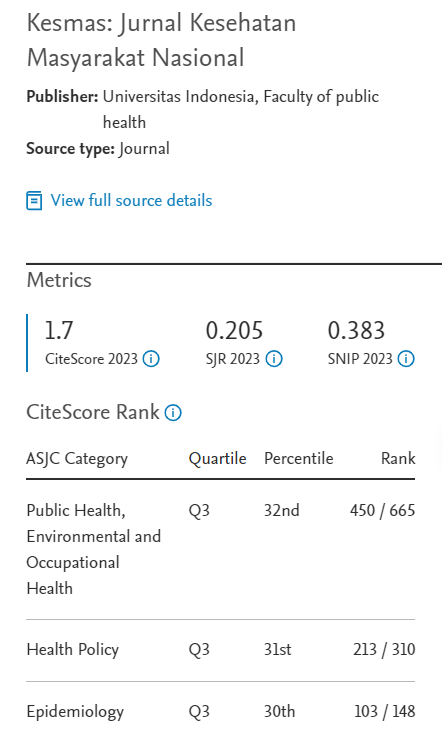Abstract
Penyakit schistosomiasis menempati rengking ke dua setelah malaria sebagai masalah sosial ekonomi dan kesehatan masyarakat di daerah tropis dan sub tropis. Prevalensi Schistosomiasis di Napu pada tahun 2004 (1,71%) masih tinggi dan cenderung meningkat. Hal tersebut didukung oleh infection rate pada keong sebagai host intermediet yang tinggi (16.3%) yang menunjukkan bahwa penularan masih terus terjadi. Tujuan penelitian ini adalah mengetahui hubungan pemanfaatan air sungai/parit dengan infeksi Schistosoma japonicum di Napu Poso Sulawesi Tengah. Penelitian dengan disain studi kasus kontrol ini menggunakan sumber data sekunder hasil survey tinja dan pengamatan dengan metode Katto Katz di Napu tahun 2006. Kasus adalah responden dengan tinja yang mengandung telur cacing Schistosoma menurut, sedangkan control adalah responden dengan tinja yang tidak ditemukan telur cacing Schistosoma. Metoda analisis yang digunakan adalah regresi logistik ganda dengan ukuran asosiasi Odd Rasio dan uji Kai Kuadrat. Penelitian ini menemukan Hubungan antara perilaku pemanfaatan air sungai/parit dengan infeksi Schistosoma japonicum setelah disesuaikan terhadap perancu yaitu penggunaan sepatu boot dan pemanfaatan jamban OR=2,31 (95%CI : 1,22-4,36).
Schistosomiasis occupies second rank after malaria as social-economic and public health problem in tropical and sub-tropical areas. In 2004, Schistosomiasis prevalence in Napu is considered high at 1.71% and tends to increase. This is supported by high infection rate at snail as intermediate host (16.3%). In general, one who infected by Schistosoma is those with habit related to the use of river water. The objective of this research is to know the relationship between risk factor of the use of river water/ditch with infection of Schistosoma japonicum in Napu, Poso, Central Sulawesi province. The source of data used in this study is survey of Schistosoma using Katto Katz method in Napu in the year 2006. Cases are respondents whose faeces contained Schistosoma egg while controls are those whose faeces did not contain Schistosoma egg. The result shows positive correlation between behavior of using river water/ditch with infection of Schistosoma japonicum after confounder control with OR=2,31 (95%CI : 1,22-4,36).
References
- Ross, Allen G.P., at.all., 2002. Schistosomiasis, Journal of Medicine, Volume 346 (8):1212-1220.
- Bierman, Wouter FW., Wetsteyn, Jose CFM., Van Gool, Tom., 2005. Presentation and Diagnosis of Imported Schistosomiasis : Relevance of Eosinophilia, Microscopy for Ova, and Serology, J. Travel Med, 12 : 9- 13 (http://www.blackwell-synergy.com/doi/pdf/10.2310/7060.2005. 00003).
- Izhar, A., Sinaga, R.M., Sudomo, M., Wardiyo, N.D., 2002. Recent Situation of Schistosomiasis in Indonesia, Acta Tropica 82 : 283-288.
- Kasnodihardjo, 1997. Masalah Sosial budaya dalam Upaya Pemberantasan Schistosomiasis di Sulawesi Tengah, Cermin Dunia Kedokteran, No. 118 Tahun 1997 :40-43.
- Payne, G., at all., 2006. Concurrent Comparison of Three Water Contact Measurement Tools in Four Endemic Villages of The Philippines. The Schistosomiasis Transmission Ecology in The Philippines Project (STEP). Tropical Medicine and International Health, Vol. II No. 6 : 834-842
- World Health Organization, 1996. Schistosomiasis, Fact Sheet No 115, WHO Geneva, akses tanggal 18/05/2006 http://www.who.ch/
- Schesselman, James J., 1982. Case Control Studies, Design, Conduct, Analysis, Oxford University Press, New York.Kelsey, J.L., at.all., 1996. Methods in Observational Epidemiology, Second edition, Oxford University Press, New York.
- Barakat, R., at.al., 2000. The Epidemiology Of Schistosomiasis in Egypt : Patterns of Schistosoma Mansoni Infection and Morbidity in Kafr El-Sheikh, Am. J. Trop. Med. Hyg. 62(2)S, pp. 21-27.
- Useh, MF., Ejezie, GC., 1999. Modification of Behaviour and Attitude in The Control Schistosomiasis. 1. Observations on Water Contact Patterns and Perception of Infection. Annals of Tropical Medicine And Paracitology, Vol. 39 (7) : 711-720
- El-Khoby, T., at.all.,2000. The Epidemiology Of Schistosomiasis in Egypt : Summary Finding in Nine Governorates, Am. J. Trop. Med. Hyg. 62(2)S, pp. 88-99.
- Massara, Cristiano L., at all.,2004. Factors Associated with Schistosomiasis Mansoni in a Population from the Municipality of Jaboticatubas State of Minas Gerais Brazil, Mem Inst Oswaldo Cruz, Rio de Jeneiro, Vol 99(Suppl. I): 127-134.
- Bethony, Jeffrey., at all, 2004. Exposure to Schistosoma mansoni infection in a rural area in Brazil. Part III : household aggregation of water contact behaviour, Tropical Medicine and International Health, Vol. 9 No.3 pp:381-389 (http://www.blackwell-synergy.com/doi/pdf/10.1111 /j.1365-3156.2004.01203.x) akses tanggal 31-07-2006.
- Sibadu, Anas., 2002. Pengaruh Pekerjaan, Status Gizi, Pemanfaatan Jamban Keluarga dan Pemanfaatan Sarana Air Bersih Terhadap Reinfeksi Schistosomiasis Japonica Pasca-Terapi di Dataran Tinggi Napu Kabupaten Poso Provinsi Sulawesi Tengah Tahun 2002. Thesis, Unair Surabaya.
Recommended Citation
Hariyanto M .
Pemanfaatan Air Sungai dan Infeksi Schistosoma Japonicum di Napu Poso Sulawesi Tengah Tahun 2006.
Kesmas.
2007;
1(5):
219-225
DOI: 10.21109/kesmas.v1i5.294
Available at:
https://scholarhub.ui.ac.id/kesmas/vol1/iss5/5







